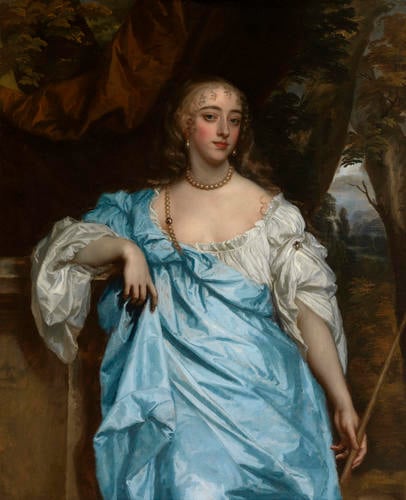-
1 of 253523 objects
Mary Bagot, Countess of Falmouth and Dorset (1645-79) c. 1664-65
Oil on canvas | 124.3 x 101.3 cm (support, canvas/panel/stretcher external) | RCIN 404958

Sir Peter Lely (1618-80)
Mary Bagot, Countess of Falmouth and Dorset (1645-79) c. 1664-65
-
This picture forms one of the 'Windsor Beauties' series, a set of eleven portraits of celebrated women at the Restoration court painted by Sir Peter Lely. The series was apparently commissioned or at least assembled by Anne Hyde, Duchess of York, probably around 1662-5. Pepys recorded on 21 August 1668 that he 'did first see the Duke of York's room of pictures of some Maids of Honour, done by Lilly: good, but not like.' By describing the pictures as 'not like' Pepys is alluding to the often noted opinion that Lely flattered his subjects, and gave each portrait a similar languorous and 'sleepy eyed' air, said to have been influenced by the features of the noted court beauty Barbara Villiers, Duchess of Cleveland (RCIN 404957) who was painted many times by Lely. Contrary to Pepys's assertion, only one of the sitters, Frances Teresa Stuart (RCIN 404514) actually held the position of Maid of Honour in the Royal Household. Some of the others were noted courtesans, while others were respected members of the nobility.
In 1674, after the death of Anne Hyde, the pictures were hanging as a group in the White Room at Whitehall which was reported as being 'Hunge wth white sarsanett [sarcenet - a soft fabric, usually of silk], and over it blew Mohair with silk fringe'. Eleven pictures are mentioned in this inventory, although ten today are identified today as belonging to the group. The series was taken from Whitehall to Windsor, presumably by James II and hung in the Princess's Dressing Room. In the reign of Queen Anne they were hung in the Queen's Waiting Room and later in the Queen's State Bedchamber. They were at Hampton Court by June 1835. All appear to be wholly by Lely's own hand except Anne Digby, Countess of Sunderland (RCIN 404515) which is probably a studio copy.
Mary Bagot (1645–79) was the daughter of Colonel Hervey Bagot and in 1664 married Charles Berkeley, Earl of Falmouth (1630–65), who was killed the following year by a cannon shot during the battle of Lowestoft. After the death of Anne Hyde, Duchess of York, in 1673, Mary Bagot was suggested as a possible bride for the duke, but in 1674 she secretly married Charles Sackville (1643–1706), later 6th Earl of Dorset and 1st Earl of Middlesex. She died in childbirth five years later. Mary is depicted in a fashionable state of 'undress', her white shift partly covered by a piece of luminous blue silk draped over her right shoulder. Many of Lely's portraits show women in this manner, with a flowing length of fabric or a loose, informal gown worn over their white linen shift, a type of casual dress that eschewed contemporary fashion and instead presented a timeless image. The lack of stays or supports to provide structure allowed for a softer appearance, with suggestions of the body beneath. The casualness of such an outfit also signified the privileged status of the wearer, since custom dictated that those of a lower social standing should not appear more informally dressed than their superiors.
Text adapted from Charles II: Art and Power, London, 2017.Provenance
Probably commissioned by Anne Hyde, Duchess of York
-
Creator(s)
Commissioner(s)
-
Medium and techniques
Oil on canvas
Measurements
124.3 x 101.3 cm (support, canvas/panel/stretcher external)
143.0 x 120.3 x 9.3 cm (frame, external)
Category
Object type(s)
Other number(s)
Alternative title(s)
The Duchess of Somerset, previously identified as (?)